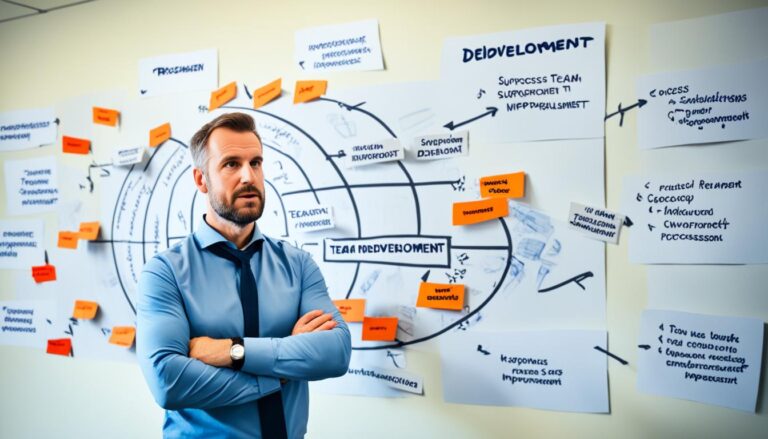Elevate Your Success with Winning Team Goals

Do you want to unlock the full potential of your team and achieve new heights of success? The key lies in setting effective team goals. When employees feel empowered and have clear goals, they are not only more productive but also experience higher job satisfaction. So, how can you set and achieve team goals that drive success for your organization?
Key Takeaways:
- Clear team goals empower employees and lead to higher productivity and job satisfaction.
- SMART (Specific, Measurable, Achievable, Relevant, and Time-bound) goals provide a roadmap for success.
- Setting collaborative goals fosters teamwork and communication among team members.
- Effective delegation, empowerment, and a learning environment are key strategies for achieving team goals.
- Prioritizing team goals creates a positive and productive work environment where your team can thrive.
The Power of Effective Goal Setting for Team Success
Setting effective team goals is essential to drive success and unlock your team’s potential. By establishing SMART (Specific, Measurable, Achievable, Relevant, and Time-bound) goals, you provide a roadmap for your team’s journey towards achieving greatness. SMART goals ensure that everyone is aligned and working towards a common objective, maximizing productivity and efficiency.
SMART team goals are:
- Specific: Clearly defined and unambiguous, leaving no room for interpretation or confusion.
- Measurable: Quantifiable, allowing you to track progress and measure results.
- Achievable: Realistic targets that are within reach for your team, considering available resources and capabilities.
- Relevant: Aligned with your team’s overall mission and objectives, directly contributing to the organization’s success.
- Time-bound: Set within a specific timeframe, creating a sense of urgency and providing a clear deadline for accomplishment.
SMART goals enable you to monitor the progress of your team and measure their performance. By having specific targets and quantifiable metrics, you can objectively evaluate the team’s achievements, identify areas for improvement, and celebrate milestones along the way.
For example, let’s say you are leading a sales team. Instead of setting a generic goal, such as “increase sales,” you can establish a SMART goal like “increase monthly sales by 15% by the end of the quarter.” This goal is specific, measurable, achievable, relevant, and time-bound. It provides a clear focus for your team, motivates them to push their limits, and allows you to track their progress effectively.
Measuring Team Goals
Measuring the success of your team goals is crucial to evaluate their effectiveness and make informed decisions. A key metric for measuring team goals is Key Performance Indicators (KPIs). KPIs provide measurable data that reflect the progress and performance of your team in achieving their goals.
Some common KPIs for measuring team goals include:
- Sales revenue: For sales teams, tracking revenue generated is a primary KPI for measuring goal achievement.
- Customer satisfaction: For customer service teams, measuring customer satisfaction levels through surveys or feedback is crucial.
- Project completion: For project teams, tracking the timely completion of deliverables and milestones is vital for goal measurement.
- Employee productivity: Monitoring individual or team productivity can help assess their performance towards achieving goals.

| KPI | Description |
|---|---|
| Sales revenue | Total revenue generated from sales activities. |
| Customer satisfaction | Level of satisfaction reported by customers through surveys or feedback. |
| Project completion | Percentage of project milestones or deliverables completed within the target timeframe. |
| Employee productivity | Individual or team productivity measured by key output metrics. |
By regularly monitoring these KPIs, you can assess the progress of your team towards their goals, identify any performance gaps, and take corrective actions if needed. Measuring team goals allows you to stay on track and make data-driven decisions to optimize performance and achieve success.
Building Collaboration and Communication through Team Goals
Effective team goals can serve as powerful catalysts for collaboration and communication among team members. When goals are designed to require synergy and cooperation, team members are naturally motivated to work together, exchange ideas, and provide support to one another in order to achieve the desired outcomes. This collaborative approach fosters a sense of camaraderie and establishes a supportive work environment that fuels productivity and strengthens the bonds within the team.
By setting collaborative team goals, you empower your team members to leverage their individual strengths and expertise while collaborating towards a shared objective. This not only enhances the overall quality of work but also encourages innovative thinking and problem-solving. Through regular interactions and discussions aimed at achieving team goals, individuals can share their diverse perspectives and ideas, leading to more comprehensive and effective solutions.
Moreover, teamwork goals create opportunities for effective communication within the team. As team members work together towards a common goal, open lines of communication are essential to ensure that everyone is aligned, has a clear understanding of their respective roles and responsibilities, and is aware of the progress being made. Regular communication can help identify challenges, address roadblocks, and refine strategies, enabling the team to stay on track and continuously adapt to changing circumstances.
In order to build collaboration and communication through team goals, consider implementing the following strategies:
- Establish clear and shared team goals: Clearly articulate the team’s goals and ensure that they are understood and embraced by all members. This shared understanding creates a sense of unity and purpose, driving collaboration.
- Promote open and transparent communication: Encourage team members to openly express their thoughts, concerns, and ideas, fostering a culture of trust and psychological safety. This enables effective communication and ensures that valuable insights are shared among team members.
- Foster a culture of teamwork: Celebrate and acknowledge instances of successful collaboration, highlighting the importance of teamwork. Create opportunities for team-building activities and foster a positive work environment where individuals feel comfortable collaborating.
- Encourage cross-functional collaboration: Look for opportunities to bring together individuals from different departments or areas of expertise. This allows for a diverse range of perspectives and encourages collaboration beyond traditional boundaries.

By incorporating these strategies and emphasizing collaborative team goals, you can create an environment that nurtures effective communication and fosters a spirit of teamwork. This collaborative approach not only improves team performance but also enhances job satisfaction and overall team dynamics.
| Benefits of Building Collaboration and Communication through Team Goals |
|---|
| Enhanced creativity and innovation |
| Improved problem-solving capabilities |
| Increased knowledge sharing |
| Stronger sense of belonging and team cohesion |
| Higher levels of motivation and engagement |
Strategies for Achieving Team Goals
Achieving team goals requires a strategic approach. By implementing effective strategies, teams can overcome challenges, stay motivated, and successfully achieve their goals. Here are some key strategies to consider:
1. Effective Delegation
Delegation plays a crucial role in achieving team goals. Distributing tasks and responsibilities among team members based on their skills and strengths ensures that the workload is efficiently managed. Additionally, delegating tasks empowers team members and fosters a sense of ownership and accountability.
2. Empowering Decision-Making
Empowering team members to make decisions not only enhances their problem-solving skills, but it also instills a sense of trust and confidence. Encouraging autonomy and recognizing individual expertise helps in driving innovation and achieving team goals.
3. Learning Environment
Fostering a learning environment is essential for achieving team goals. Emphasize the importance of continuous improvement and growth, and encourage team members to view mistakes as opportunities for learning and development. Providing resources and opportunities for training and development further supports the team’s ability to achieve their goals.
4. Recognition and Celebration
Recognizing and celebrating achievements along the way is vital for maintaining the team’s motivation and morale. Acknowledging individual and collective efforts boosts morale and reinforces a positive team culture. Celebrate milestones and accomplishments to keep the team engaged and enthusiastic about achieving the ultimate goal.
By incorporating these strategies into your team’s approach to goal achievement, you can optimize collaboration, enhance productivity, and ultimately achieve effective team goals.

Conclusion
Setting and achieving effective team goals is the key to unlocking the full potential of your team and driving success. By setting SMART goals that are Specific, Measurable, Achievable, Relevant, and Time-bound, you provide a clear roadmap for your team’s journey to success.
Collaboration and communication are vital in achieving team goals. By fostering a collaborative work environment where team members actively work together, share ideas, and support each other, you create a strong bond among team members and enhance productivity.
In addition to setting goals and fostering collaboration, it is important to celebrate achievements along the way. Recognizing and appreciating the hard work and accomplishments of individuals and the team as a whole boosts morale, motivates team members, and reinforces a positive and productive work culture.
By prioritizing team goals, implementing the strategies discussed in this article, and creating a supportive work environment, you are setting your team up for success. With a clear vision, effective communication, and a motivated team, you can achieve great things and propel your team to new heights of success.
FAQ
Why are team goals important for success?
Team goals provide a clear direction and purpose for the team. They promote alignment, motivation, and productivity among team members, leading to higher performance and job satisfaction.
How should team goals be set?
Team goals should follow the SMART (Specific, Measurable, Achievable, Relevant, and Time-bound) principle. This ensures that goals are well-defined, measurable, realistic, and aligned with the team’s objectives.
How does setting effective team goals promote collaboration?
When team goals require collaboration, team members are encouraged to work together, share ideas, and support each other. This fosters a collaborative work environment, strengthens team bonds, and enhances overall performance.
What strategies can teams use to achieve their goals?
Strategies for achieving team goals include effective delegation, empowering team members, fostering a learning environment, and recognizing and celebrating achievements. These strategies help teams overcome challenges, stay motivated, and successfully achieve their goals.
Why is it important to measure team goals?
Measuring team goals allows you to track progress, identify areas of improvement, and make necessary adjustments. It provides valuable insights into the team’s performance and helps in evaluating the success of the goals.






